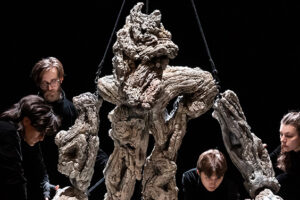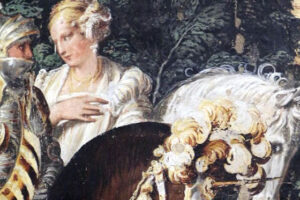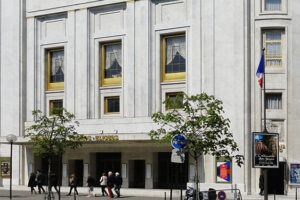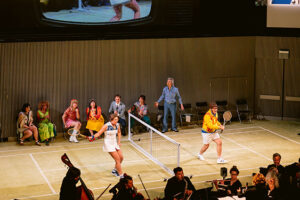
A new CD
features the ten most gorgeous minutes recorded by a tenor in Wagner since World War II. It is Jonas Kaufmann singing from Act Two of Siegfried “Dass der mein Vater nicht ist… Du holdes Vöglein!” – otherwise known as “The Forest Murmurs.” This fragment lies perfectly for him, in the very middle of his voice, with a brief G the highest note. His tone is sumptuous and flows effortlessly with the glamour, distinctiveness and immediate recognizability that define a great “classical” singer. He is able to sing over a wide dynamic range from breathtaking softness, always full bodied, to a ripe but never heavy sound at fuller voice, and there is wonderful contrast throughout.
He uses, apparently spontaneously, a quick messa di voce (the tone is swelled and diminished) and is able to mirror the feelings in this selection by shifting subtly the weight and resonance of his sound. Nostalgia and longing are conveyed with virile sweetness. There is a touch of the heroic in the darkness of sound he summons and yet there is a hypnotic, youthful float throughout. At this point Siegfried is still a vulnerable boy, which Kaufmann conveys precisely. Word and tone balance are perfect: his pronunciation is a musical pleasure in itself and it gives his sound specificity–every moment is realized fully.
Donald Runnicles, the conductor, gives Kaufmann plenty of space. This is a very romantic approach to the music. One challenge in this selection especially at this rather slow tempo is that of line; young Siegfried, alone in the forest, is talking to himself, lost in memories and as yet unknown desires–he stops now and then. And yet the tenor must manage a full, complete journey through this music, despite the pauses, the changes, the rhythmic shifts, the sudden anger at the memory of Mime. Kaufmann is simply phenomenal in doing this–one is aware of him through the silences, an effect achieved through precise rhythm, a very sensitive blending to the sonority of solo instruments, phrases that lead the ear on through silences and orchestral commentary.
The winds of the orchestra of the Deutsche Oper Berlin are terrific, and the sudden smile in the tone as he fails to make music with a reed is irresistible. True, Siegfried Jerusalem and Rene Kollo
do this selection very well on their records too, and both are wonderfully accompanied (Bernard Haitink does so well by Jerusalem that it becomes a highlight of that entire Ring). Yet neither can manage the beauty and specialness of tone that Kaufmann shows here, and, terrific as they both are, neither spins out this music so languorously.
An older Wolfgang Windgassen does this stretch fairly well with Georg Solti, helped by Decca/John Culshaw’s electrical magic–though neither he nor the conductor has the rhythmic firmness the section needs to live. The tenor is better with the tender Kna of 1956
. Ludwig Suthaus and Wilhelm Furtwaengler together create genuine magic, though the tenor’s technique is one of shrewd compromises and the vicissitudes
of the RAI orchestra are distracting.
One can also enjoy the heartier Hans Hopf under the wonderful Rudolf Kempe at Bayreuth (he’s tenser under Erich Leinsdorf in the Met broadcast
). Another factor in favor of Windgassen and Hopf (both at Bayreuth) is that they are singing live and are miked in a “general” way. The one caveat I have about Kaufmann is that this is a spectacular sounding multi-microphone studio recording. In the album notes he praises the venue (the “old East Berlin radio studio”) but evidently this acoustic has been arranged to flatter all concerned. Still, comparing apples to apples, this is a stunning testament to Kaufmann’s remarkable talent.
To suggest that nothing else here is quite so memorable is not at all to damn this CD with faint praise. If Kaufmann has some limits, much here is beautifully done, and his sophistication and insight are always very impressive. A role he has actually sung is Walther in Die Meistersinger – it was a concert that was broadcast and a tape survives. Of course, back then Kaufmann had a brighter, lighter sound. Here he sings with more weight but it seems to me, more beauty as well. The selection, the short “Am stillen Herd” from act one is only a morsel but it is done with much wit and charm.
I love the way he toys with rhythm, especially in the phrase “wie einst der Lenz so lieblich lacht, und wie er bald wohl erwacht” – he deliberately emphasizes the appoggiaturas on “lacht” and “erwacht” making something special of the last, a high E (dotted quarter), falling into the D below, a dotted eighth with a fermata over it–spinning his tone gorgeously from the higher to lower note. He also has a plausible trill at the end. This stretch too lies easily for him and the roundness of tone promises much if, as he promises in the notes, he actually sings the entire role again.
Kaufmann has not sung Tannhäuser and, in the liner notes, tells interviewer Thomas Voigt that he had no intention of singing it–until he recorded “Inbrunst im Herzen.” He has a lot of competition here and in general there isn’t the wildness of Windgassen in the Bayreuth recording (who can forget his scream at “Da ekelte mich der holde Sang?”) or the heartbroken, exhausted intensity of Ramon Vinay, also
from Bayreuth, though he had a Southern accent (being from Chile?) Then there is Hopf again, a tough character bought low (better live
than on the too closely miked EMI
).
Kaufmann does not try for that kind of intensity or rage. He sings with meaningfully inflected if not always crystalline words, wonderful line and an alluring tone, more enticing than the competition–yes, that includes the very capable Kollo and Seiffert
, and someone named Domingo who cooks up heartbreak alla Zarzuela
in a language of his own devising. Kaufmann conveys tense urgency and a sense of shame to start but then comes up with a chilling, eerie tone as he quotes the Pope cruelly dismissing Tannhäuser. His coloring and timing of the phrase, “Wie dieser Stab in meiner Hand nie mehr sich schmückt mit frischem Grün, kann aus der Hölle heissen Brand” is unforgettable.
But Kaufmann has planned this reading to build to the invocation of Venus. As the line gets higher and grows more fervid he opens his tone thrillingly and soars through the blasphemous praise of the Goddess – it’s so stunning one is mighty disappointed that the excerpt ends so abruptly (the CD provides a Wolfram in Markus Brück). So, the slow boil approach works very well, though it’s not crazy enough for my taste.
Rienzi’s Prayer is elegantly done; for one thing, he does the turn precisely and beautifully. If there isn’t quite the solidity of Lauritz Melchior, compared to more recent tenors Kaufmann is more than competitive.
Of all the roles represented on this disc he is best known as Lohengrin. A performance I saw in Munich (with the great Michaela Schuster as Ortrud) was unforgettable. Here he sings both verses of “In fernem Land.” He does well and yet there isn’t quite the sweet float at the beginning I remember live (a performance in the run is on tape and quite wonderful), and I noticed some obvious vowel modifications. In particular he does something odd with the high A on the “i” in “Ritter” in the line “sein Ritter ich–bin Lohengrin genannt” and the earlier, longer A on “Gral” is also a modified vowel. Returning to other selections one the disc, one notices now and then some of these vowel changes – in the Tannhäuser especially.
This reminds me of a story Kaufmann told an early interviewer about the American pedagogue who rescued him from being a comprimario with a piping high voice by changing the way he produced his sound. It sounds as though he studied the so-called Stanley technique developed in America by Douglas Stanley, which had a real vogue in Germany. Jerome LoMonaco, a tenor in German houses, taught it, and there is also an Italian version taught by Arturo Morlocchi, whose star pupil was Mario del Monaco.
Stanley promises that his technique, which involves lowering the larynx as far as it will go and applying a lot of breath pressure, over time will build formidable volume and a strong dark timbre in the middle and lower part of the voice. Many pedagogues dislike this technique and, to be sure, it has real traps; on the other hand, true believers argue that used responsibly and not rigidly it does indeed build volume and impact, increase stamina and usually does not interfere with high notes.
Oddly enough, in his conversation with the Thomas Voigt in the liner notes, Kaufmann refers admiringly to Franz Volker because of his “beautiful” singing in Lohengrin. But Volker taught the Stanley Method, with a spoon shoved down the throat to be sure the larynx was as low as possible and the tongue didn’t ride up. I wonder about Kaufmann. The first time I heard him at the Met (Traviata!), his voice was small and light and did not project well. I had earlier heard him live in Zurich, in Königskinder >displaying a dazzling sexual charm and a lovely tone (it’s now on DVD), and very strong in Parsifal but his voice did not promise so much for a massive place like the Met. That obviously has changed. I don’t believe Kaufmann is “locked” into the Stanley method but some aspect of it may be how he developed the dark lower range and fuller sound that now distinguish his singing.
After that demonstration of digression on parade we can return to this CD. I admit I was not terribly impressed with Kaufmann’s Siegmund live; however, from a recording perspective he’s better sounding than most others on disc. He’s superior, certainly, to Peter Hoffmann in the New York Philharmonic first act, to Gary Lakes or Poul Elming, or the too light though attractive sounding Jerusalem, or Windgassen and Alberto Remedios for whom the role is too low, or the average Manfred Schenk Robert Schunk. Yes, James King sounds more at ease in the lower tessitura but is a duller interpreter. It must perhaps be said that if you didn’t hear Jon Vickers in the huge Met, you have no idea how this music can sound on that immense scale, and so the smaller scope of Kaufmann’s Siegmund isn’t so apparent or relevant. (On the Leinsdorf recording
, Vickers sings wonderfully and you do get a sense of the sheer impact and heart of his singing.)
In Kaufmann’s performance of the monologue “Ein Schwert verhiess mir der Vater” that starts this collection, the tenor does indeed produce a chocolatey, rich tone in the low tessitura of this stretch of the role. But I hear some of those vowel modifications, a lack of power in reserve, suggesting there is perhaps some contrivance involved in producing this dark tone for so long. In the notes, Kaufmann mentions the Melchior live recordings where “his calls of ‘Wälse’ are endlessly long and endlessly big.” Predictably, the high point of this aria is the build to the G-flat and G, with Runnicles slowing down just a bit to let Kaufmann savor the highest note excitingly.
In the Wesendonck Lieder, Kaufmann floats with great beauty and sensitivity through “Der Engel” and “Stehe still!”—among the best selections on the CD. In “Im Treibhaus” I noticed that laryngeal shift. “Schmerzen” and a rather loud “Träume” are solid but unmemorable readings. There’s a shift in acoustics for “Schmerzen,” where the voice doesn’t sound entirely settled.
However, despite my quibbles and quiddities, this is a wonderful, stimulating collection by a remarkable singer.

























Comments